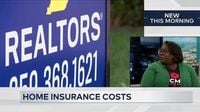As Americans grapple with a housing market already beset by high interest rates and limited inventory, a new challenge is rapidly gaining ground: surging home insurance costs driven by increasingly frequent and severe climate-related disasters. From the windswept plains of Iowa to the flood-prone neighborhoods of Houston and the wildfire-scarred hills of California, homeowners and would-be buyers are facing tough decisions as insurance premiums soar, coverage shrinks, and some insurers pull out of entire markets altogether.
On November 12, 2025, the fifteenth annual Iowa Climate Statement, signed by 177 scientists statewide, sounded the alarm on this growing crisis. According to the statement, "Rising insurance premiums in Iowa are driven by increased costs of labor, building materials, and reinsurance. These costs are all amplified by climate change and are escalating. In some cases, insurers are leaving certain markets, including Iowa, due to rising costs," said Peter Thorne of the University of Iowa. The scientists warned that Iowa is not alone in facing these pressures—states like Florida, California, and Texas are already experiencing even sharper increases as hurricanes, flooding, and wildfires become more severe.
The numbers are sobering. According to Real Estate News, the cost of a standard homeowners policy in the U.S. jumped over 40% from 2019 through 2024, with the largest increases coming in the past two years. In high-risk regions, the pain is even more acute: homeowners paid an average of $500 more in annual premiums in 2023 than those in safer areas, a gap that has grown from $300 in 2018, according to the National Bureau of Economic Research. But these statistics only hint at the real-world impact on families and communities.
Take Oklahoma, for example. As of November 11, 2025, homeowners there were paying nearly three times the national average for home insurance. Kimberly Robbins, president of the Oklahoma City Metropolitan Association of Realtors, described the strain this places on buyers and sellers alike. "It does factor into the cost of their house," Robbins explained. "As realtors, it’s our job to lead them and guide them to make sound decisions when it comes to that." Many Oklahomans have seen their premiums jump by hundreds of dollars a month, forcing families—especially first-time buyers and those on fixed incomes—to lower their price range or rethink homeownership altogether.
"It really hits the first-time home buyer and people on fixed incomes more than others," Robbins told local media. "It’s just a variable we didn’t have to consider before, but now we do." To help clients navigate these turbulent waters, the Oklahoma City Metropolitan Association of Realtors leans on data from MLSOK, a regional listing service, to educate buyers and sellers about current insurance trends. "It’s about getting all of the information out so families can make a decision that fits their finances," Robbins said. Her advice to homeowners is practical: shop around, include insurance costs in your budget, and make sensible choices for your family.
The causes of these premium hikes are multifaceted, but one factor looms large: the increasing frequency and intensity of extreme weather events linked to climate change. In the first week of July 2025, the Madre fire scorched over 50,000 acres in California, eclipsing the devastating Los Angeles fires from January to become the state's largest blaze of the year. That same week, flash floods in Central Texas claimed more than 100 lives—the deadliest such event in the U.S. in half a century. According to the National Centers for Environmental Information, 2024 saw 27 weather- or climate-related disasters with losses exceeding $1 billion each—twice the annual average for the previous 40 years, even after adjusting for inflation.
These disasters don't just bring heartbreak and loss; they upend the economics of homeownership. Mortgage providers require insurance, so as premiums climb, so too do the monthly costs for buyers. In Miami-Dade County, Florida, the impact has been dramatic: the average homeowner's premium soared by 322% from 2019 to 2024, reaching $6,000 per year—double the state's average. Many have turned to Citizens Property Insurance Company, the state's insurer of last resort, but such policies often offer less robust coverage, leaving homeowners exposed to greater risk. Unsurprisingly, Miami has seen a spike in residents looking to move elsewhere, ranking fifth nationally for net outflow in 2024 according to Redfin.
Houston, Texas, tells a similar story. After suffering $160 billion in damages from Hurricane Harvey in 2017, and enduring further floods in subsequent years, Harris County’s average insurance premium rose 43% to $3,325 between 2015 and 2023. Some neighborhoods saw increases closer to 60%. Following Hurricane Beryl in 2024, major insurers like Progressive and Foremost Insurance pulled back, leaving the Texas FAIR Plan—the state’s last-resort insurer—to pick up the slack. In the first quarter of 2025 alone, the FAIR Plan issued 110% more policies statewide than five years prior, with Harris County accounting for over 42% of them. While Houston continues to attract newcomers, net in-migration fell by more than 46% between 2023 and 2024.
California is also feeling the squeeze. Following the Palisades and Eaton fires in Los Angeles County in January 2025, private insurers sought $1 billion in relief from state regulators to cover their losses—a cost that will inevitably be passed on to consumers. The average annual premium in California is expected to rise by 21% in 2025, approaching $3,000, according to an Insurify analysis. Major insurers like State Farm have stopped writing new homeowner policies, and the state’s FAIR Plan has seen a 289% surge in enrollment since 2021. First Street, a climate risk analytics firm, now labels Los Angeles County a "tipping point" community, projecting a population decrease over the next 30 years as insurance challenges mount.
The ripple effects are already visible in homebuyer behavior. A Realtor.com survey in August 2025 found that more than a third of prospective and recent buyers (33.7%) had to change the geographic area of their home search due to insurance challenges. Thirty percent said they considered natural disaster risk data during their search, and 44% planned to do so in the future. First-time buyers, who typically rely on mortgages and are thus required to carry insurance, are feeling the pinch most acutely. Sellers, meanwhile, may face a shrinking pool of buyers and be forced to offer concessions or lower prices.
Policymakers and industry professionals are scrambling to respond. State legislatures and insurance commissioners are enacting laws to promote price transparency and set thresholds for rate hikes. Some states, like Alabama and Louisiana, are focusing on preventive measures—offering grants for wind-resistant home upgrades or mandating stricter elevation requirements in flood zones. California now requires fire-resistant materials and vegetation management in wildfire-prone areas. Real estate professionals, for their part, are being encouraged to educate clients about climate risks and insurance costs, highlight climate resilience features, and help buyers budget for potential mitigation efforts.
As the climate crisis accelerates, the intersection of weather, insurance, and real estate is reshaping the American dream of homeownership. For many, the path to a new home now winds through a landscape of hard choices, rising costs, and an urgent need for resilience in the face of an uncertain future.






